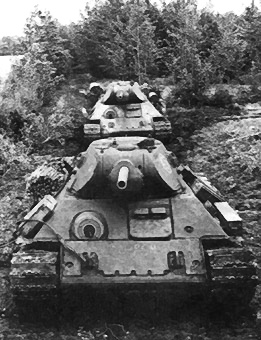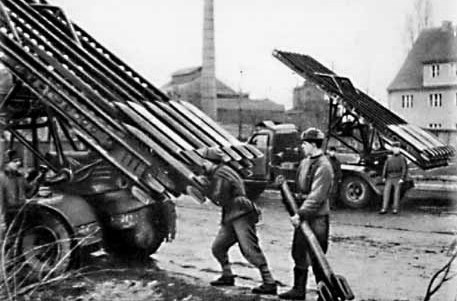|
Soviet
Weaponry.
One of the great shocks to Hitler and his generals was the discovery
after the
battle of Moscow that the Russians were in general not ahead of them
in weaponry,
but T-34 tank was superior to anything the Germans had in 1942. (1)

T-34 tank.
It was not just a question of design and power but also a question
of
production. The Russians were producing thousands of tanks by
1943,
and their production continued to climb as the German production faltered.
The Germans did have an effective weapon agains the tanks, a hollow-core
explosive shell that could knocked out the crew of a whole tank if
fired from a
88mm gun. But these were short in supply. The Russians also had the
Katyusha (2), known as Stalin's
Organs, mulptiple rocket launchers which
could put up a barrage from thirty-six barrels carried on the
back of a truck.
The Germans copied the Katyusha and introduced it in 1943 in North
Africa
as the Nebelwerfer. They also supplemented their own very effective
88mm(3)
guns with the Russian 76,2mm F-22 USV field gun (or previous version
- the
76.2mm F-22 field gun) captured in the early days of the Stalin suicidal
army attacks.
 1. By the mid-1942
Russian T-34 lost its superiority with introducing
German 75mm PaK 40 field gun and modern long
barreled Pz-IV's.
In general, in 1942-43 Russians didn't have ant
superior weapons. They
had either equal either inferior weapons. The
situation was ever more
dramatic due to big shortage of ammo. A whole
battery of a field guns
might have one round per gun... or even less.
2. Germans started
their rocked launchers earlier then
Russians, but didn't use them so widely as Russians.
Only with great
success of Stalin's Organs, Germans continued
their works on tactic
rocketry. The Nebelwerfer was copied from Katyusha.
3. Dual purposes
8,8-cm Flak 36 were although very rare and too expensive to be
produced in great amount. Germans used however,
Soviet 85mm antiaircraft
gun. Special antitank gun - 8,8-cm PaK43 - was
introduced in later 1943. |